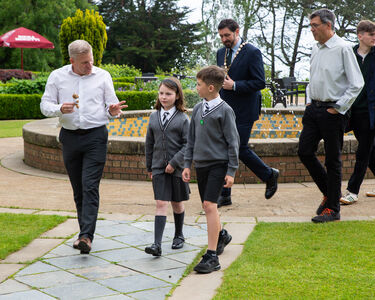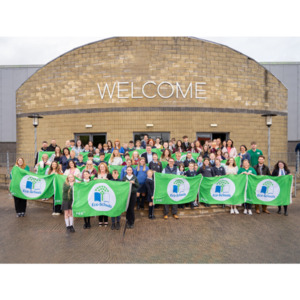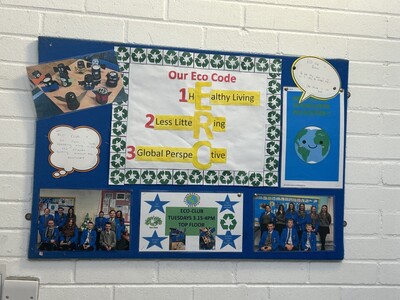1. Eco-Committee
The Eco-Committee is a group of students and school staff who work together to make their school more eco-friendly. They lead environmental projects and guide the school toward achieving the Green Flag Award.
Who is on the Eco-Committee?
-
Students from different year groups
-
A teacher or adult eco-coordinator
-
Ideally includes other staff, parents, and admin
Some schools hold elections to choose committee members, complete with speeches and posters.
What does the Eco-Committee do?
-
Holds meetings (at least twice per term)
-
Completes an environmental review and action plan
-
Keeps meeting records (minutes)
Involves the whole school in decisions
-
Shares updates and promotes environmental awareness
Tip: Invite your local council’s Environmental or Recycling Officer to a meeting for extra support. Find details on the Eco Schools Partners page.

2. Environmental Review
As you begin your Eco-Schools journey, your first step is to understand your school's current environmental impact. The Eco-Committee should complete the Environmental Review Form to identify strengths, weaknesses, and areas for improvement.
Think of the review as finding your starting point on a map—it helps you set realistic goals and track progress.
Choose the Review Form that fits your school:
-
Nursery
-
Primary
-
Post-Primary
Benefits of the Environmental Review:
-
Shows your school’s current environmental status.
-
Ensures no key areas are missed.
-
Identifies what’s working well.
-
Helps set clear, achievable goals.
-
Forms the foundation of your Action Plan.
When Applying for the Green Flag:
You'll need to show how and when you did the review, who was involved, and your results—so remember to upload and save everything!
3. Action Plan
The Action Plan is at the heart of the Eco-Schools Programme. It helps your school set clear, time-based goals to tackle the issues found in your Environmental Review.
Using the road trip analogy, the Action Plan is your route planner, showing exactly how you’ll reach your environmental goals.
Key Points:
-
Include ways to monitor and measure progress.
-
Set measurable targets (e.g. reduce waste by 50% in 6 months, cut electricity use by 10%).
-
Involve the whole Eco-Committee in planning.
-
Engage the wider school community in taking action.
-
Link activities to the school curriculum.
Be developed from the results of your Environmental Review
Contain realistic and quantifiable goals and targets.
Be displayed on your Eco Schools notice board
Be in table format (as in our portrait template or landscape template

4. Monitoring and Evaluation
Monitoring and evaluating your Eco-Schools activities is essential—it gives your programme credibility and shows how effective your actions are.
Why It Matters:
-
Tracks progress toward your Action Plan goals.
-
Highlights what’s working and what needs improving.
-
Keeps the momentum going by involving the whole school.
-
Helps integrate sustainability into everyday school life.
Student Involvement:
Encourage students to lead monitoring efforts—this builds ownership and reduces the burden on staff.When & How to Monitor:
Monitoring should begin alongside your Action Plan and continue regularly. Use the Data Zone for guidance and upload your results as they form key evidence for your Green Flag Award.
Examples of What to Monitor:
-
Utility meter readings to track energy or water savings.
-
Waste audits to measure recycling or landfill reduction.
-
Travel surveys (e.g. car miles saved during walk-to-school weeks).
-
Food diaries to support healthy living.
-
Wildlife counts for biodiversity tracking.
-
Photos (before/after) for visual evidence.
-
Feedback from pupils, staff, and community.
Sharing Results:
- Display data in charts/graphs on noticeboards, websites, and newsletters.
-
Give updates at assemblies, school council, or governor meetings.
-
Celebrate successes and explain any changes made to improve results.
Evaluation Tips:
-
Compare new data with your starting point.
-
Adjust your Action Plan as needed based on what the data shows.
-
Keep all records—you’ll need them for your Green Flag application.
Use measurable units (e.g. bin counts, kWh, water cost per pupil). Always take before and after measurements to clearly show progress.

5. Linking to the Curriculum
Eco-Schools should connect with the school’s curriculum wherever possible. Ideally, your curriculum work should support your Action Plan, making activities more relevant and engaging for students.
Why It Matters:
-
Strengthens learning through real-life application.
-
Increases student motivation and involvement.
-
Helps embed sustainability across the school.
Recognition & Support:
-
Eco-Schools supports Education for Sustainable Development (ESD).
-
Backed by the Education Authority and included in the Northern Ireland Curriculum.
-
Part of the NI Sustainable Development Strategy and a government target.
6. Informing and Involving
Eco-Schools is for everyone—students, staff, families, and the wider community. Schools can become powerful role models for sustainable living.
While the Eco-Committee leads the way, it’s important that as many students, staff, and families as possible are involved and feel proud of their impact.
How to Get Everyone Involved:
At School
-
Elect a student-led Eco-Committee.
Encourage your students to be Eco-Reporters and participate in Young Reporters for the Environment!
-
Use a notice board in a visible area to display updates.
-
Share progress in assemblies, school newsletters, or a dedicated Eco-Schools newsletter.
-
Link Eco-Schools activities to lessons and homework.
In the Community
-
Involve parents, local businesses, and councils—ask for advice, support, or funding.
-
Invite guest speakers to school.
-
Extend activities beyond school—e.g., family recycling challenges or walk-to-school campaigns.
-
Celebrate achievements in local newspapers, community halls, or libraries.
On Social Media
Share your school’s eco journey online:
-
Facebook: @EcoSchoolsNI
-
Instagram: @ecoschools.ni
-
Twitter: @Eco_SchoolsNI
Days of Action
Get the whole school and community involved with hands-on events:
-
Litter picks
-
Healthy eating days
-
Outdoor lessons
These events bring your Action Plan to life!
7. Eco-Code
The Eco-Code is your school’s mission statement for sustainability. It should reflect your values and commitment to improving the environment.

A lovely example from Edmund Rice College in Antrim and Newtownabbey.
What Should It Look Like?
The format is up to you—be creative! It can be:
-
A list of promises
-
A poem, song, or rap
-
An acrostic or acronym
Make sure it’s age-appropriate and created by students to encourage ownership and pride. You can even hold a school-wide competition to choose the best one!
Where Should It Go?
Display your Eco-Code:
-
In every classroom
-
On the Eco-Schools notice board
-
In shared spaces and the staff room
Link your Eco-Code to your Action Plan—it should reflect real goals and actions your school is taking.
Tips:
-
Tie the Eco-Code into literacy lessons.
-
Use it as a slogan or chant to engage the whole school.
-
Review it regularly to keep it relevant.
Top Tip: Use a catchy format like an acronym (e.g. GREEN: Grow, Reuse, Educate, Energy, Nature) to make it memorable and fun!
